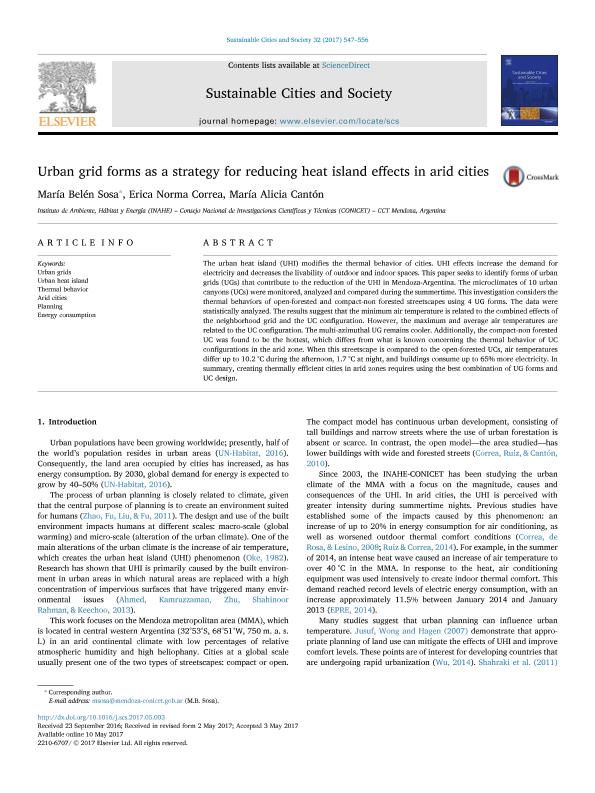Mostrar el registro sencillo del ítem
dc.contributor.author
Sosa, María Belén

dc.contributor.author
Correa Cantaloube, Erica Norma

dc.contributor.author
Canton, Maria Alicia

dc.date.available
2018-03-27T17:27:41Z
dc.date.issued
2017-07
dc.identifier.citation
Sosa, María Belén; Correa Cantaloube, Erica Norma; Canton, Maria Alicia; Urban grid forms as a strategy for reducing heat island effects in arid cities; Elsevier Ltd; Sustainable Cities and Society; 32; 7-2017; 547-556
dc.identifier.issn
2210-6707
dc.identifier.uri
http://hdl.handle.net/11336/40168
dc.description.abstract
The urban heat island (UHI) modifies the thermal behavior of cities. UHI effects increase the demand for electricity and decreases the livability of outdoor and indoor spaces. This paper seeks to identify forms of urban grids (UGs) that contribute to the reduction of the UHI in Mendoza-Argentina. The microclimates of 10 urban canyons (UCs) were monitored, analyzed and compared during the summertime. This investigation considers the thermal behaviors of open-forested and compact-non forested streetscapes using 4 UG forms. The data were statistically analyzed. The results suggest that the minimum air temperature is related to the combined effects of the neighborhood grid and the UC configuration. However, the maximum and average air temperatures are related to the UC configuration. The multi-azimuthal UG remains cooler. Additionally, the compact-non forested UC was found to be the hottest, which differs from what is known concerning the thermal behavior of UC configurations in the arid zone. When this streetscape is compared to the open-forested UCs, air temperatures differ up to 10.2 °C during the afternoon, 1.7 °C at night, and buildings consume up to 65% more electricity. In summary, creating thermally efficient cities in arid zones requires using the best combination of UG forms and UC design.
dc.format
application/pdf
dc.language.iso
eng
dc.publisher
Elsevier Ltd
dc.rights
info:eu-repo/semantics/openAccess
dc.rights.uri
https://creativecommons.org/licenses/by-nc-sa/2.5/ar/
dc.subject
Arid Cities
dc.subject
Energy Consumption
dc.subject
Planning
dc.subject
Thermal Behavior
dc.subject
Urban Grids
dc.subject
Urban Heat Island
dc.subject.classification
Investigación Climatológica

dc.subject.classification
Ciencias de la Tierra y relacionadas con el Medio Ambiente

dc.subject.classification
CIENCIAS NATURALES Y EXACTAS

dc.title
Urban grid forms as a strategy for reducing heat island effects in arid cities
dc.type
info:eu-repo/semantics/article
dc.type
info:ar-repo/semantics/artículo
dc.type
info:eu-repo/semantics/publishedVersion
dc.date.updated
2018-03-27T13:37:13Z
dc.journal.volume
32
dc.journal.pagination
547-556
dc.journal.pais
Países Bajos

dc.journal.ciudad
Amsterdam
dc.description.fil
Fil: Sosa, María Belén. Consejo Nacional de Investigaciones Científicas y Técnicas. Centro Científico Tecnológico Conicet - Mendoza. Instituto de Ambiente, Hábitat y Energía; Argentina
dc.description.fil
Fil: Correa Cantaloube, Erica Norma. Consejo Nacional de Investigaciones Científicas y Técnicas. Centro Científico Tecnológico Conicet - Mendoza. Instituto de Ambiente, Hábitat y Energía; Argentina
dc.description.fil
Fil: Canton, Maria Alicia. Consejo Nacional de Investigaciones Científicas y Técnicas. Centro Científico Tecnológico Conicet - Mendoza. Instituto de Ambiente, Hábitat y Energía; Argentina
dc.journal.title
Sustainable Cities and Society
dc.relation.alternativeid
info:eu-repo/semantics/altIdentifier/doi/http://dx.doi.org/10.1016/j.scs.2017.05.003
dc.relation.alternativeid
info:eu-repo/semantics/altIdentifier/url/https://www.sciencedirect.com/science/article/pii/S2210670716304152
Archivos asociados
